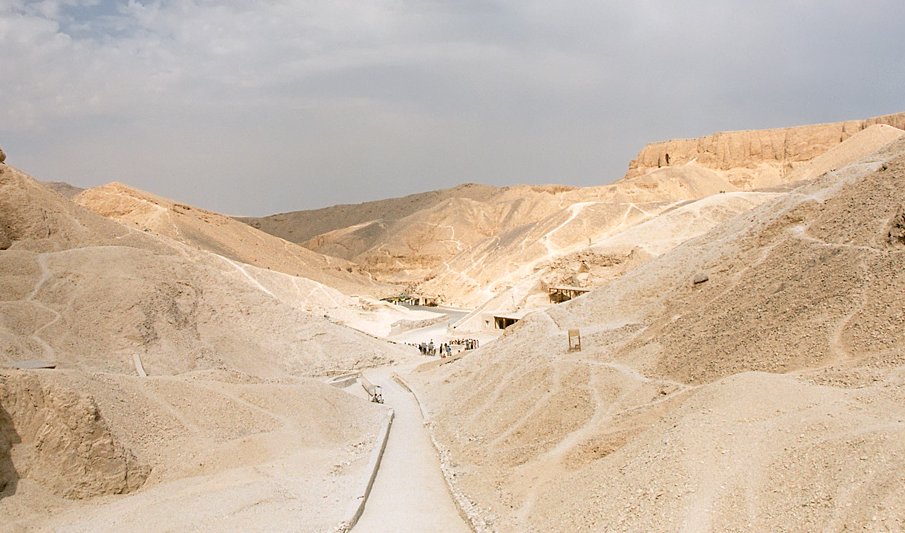Egyptian Artisans In The Valley Of The Kings Had Permanent Jobs In The Time Of The Pharaohs
A. Sutherland - AncientPages.com - During the 18th to 20th Dynasties of the New Kingdom of Egypt (ca. 1550–1080 BC, Egyptian artisans who worked on the royal tombs in the famous Valley of the Kings lived in the village of Deir el-Medina, situated in the territory of modern Luxor.
Ancient burial chambers for Pharaohs with hieroglyphics at the valley of the kings, Luxor, Egypt. Credit: Adobe Stock - whatafoto
Thousands of potsherds and limestone fragments that describe the everyday life of the artisans and their families were unearthed in Deir el-Medina. Much of these finds shed light on the village's life, but unfortunately, large parts of them have still not been examined.
Craftsmen lived in townhouses and worked eight hours a day in the" Artisan Village" (now Deir el-Medina). If they did not get paid, they usually stopped working and went on strike.
About 3500 years ago, the artisans dug out, carved, and adorned the rock-cut royal tombs across the burial ground for pharaohs who chose the Valley of the Kings for their resting place.
The work was challenging because of their daily two-kilometer-long walk from their homes over the steep Theban hills to the royal cemetery.
The tombs in the Valley of the Kings were built by highly qualified experts who earned a good salary for their work and had enough time for their families. Once a pharaoh had been buried, the workers could set to work on the next tomb.
Their profession was traditionally passed down from father to son.
A view down the Valley of the Kings, Luxor, Egypt. Image credit: Przemyslaw "Blueshade" Idzkiewicz - CC BY-SA 2.5CC
Since the end of the 19th century, archaeological diggings at the site revealed the ruins of the artisans' homes, their tools, and many texts written on papyrus, limestone fragments, or potsherds.
It was the village's scribe whose task was to keep records of the tomb's construction, although some of the artisans were also literate.
So how was the Egyptian artisans' life more than 3,000 years ago?
Eight-Hour Working Day
Approximately 40-60 craftsmen worked on the tombs. Divided into two groups, they worked on opposite sides of the grave. At the head of each group was a foreman, who observed the artisan's job to later report directly to the vizier, a respected and feared figure that regularly inspected the work in the necropolis. Other high officials also' oversaw from Thebes the excavation of the royal tombs, the names, families, and other details of the lives of many of the scribes, foremen, and workers who lived at Deir el Medina'.
Nine Days Of Work And The Tenth Day Was Off
"The artisans hiked from Deir el-Medina over the Theban hills to stone huts, still standing as ruins just above the Valley of the Kings. They lived in these huts during the workweek, descending and ascending the hill to the valley each day. At the end of the week, they returned to Deir el-Medina." 1
It was their day off, and they could meet their families or devote the day to other activities. The artisans and their families lived in Deir el-Medina's small townhouses, with three rooms and a kitchen with a roof terrace.
It was always the same road over Theban hills, but it was a tiring steep climb. Therefore many workers suffered from a degenerative joint disease known as osteoarthritis in their workers' case located in the knees and ankles, according to a new study.
The working days were rarely longer than eight hours, and it was rare that everyone was at work simultaneously. The absence was usually linked to a disease, drinking too much beer, or sometimes it had to do with repairs of the house or the wife's birth of a child.
Criminals On Trial
A council of elders ('kenbet') dealt with small cases involving minor disputes and claims. Simple misunderstandings were solved before the Oracle, a statue of the divine Pharaoh Amenhotep I. With the help of a priest, the Oracle 'answered' no or yes to a questionable issue.
Amazing hieroglyphics inside the tombs of pharaohs in the Valley of the Kings, Luxor, Egypt Credit: Adobe Stock - jon_chica
Kenbet treated cases of stealing between two villagers, but other theft cases (thefts out of temples) were investigated much more seriously and handed over to the state.
Grave Robberies And Death Penalty
Hard to say precisely how the cases of 'temple thefts used to end more than 3,00 years ago in the Valley of the Kings. However, it is known that the accused was 'taken to the river bank' by the vizier's scribe.
The person was interrogated and then punished. The minor crime was punishable by penal labor or flogging, but serious grave looting was punishable by death.
Deir el Medina (Dayr al Madinah) is an ancient Egyptian village that was home to the artisans who worked on the tombs in the Valley of the Kings illustration by David Roberts (1796-1864). Credit: Public Domain
Once a month, the artisans' salaries were paid in grain used in baking bread and producing beer, but it was also a means of payment.
An ordinary artisan received about five sacks of grain a month, and those who were better qualified received more. One bag held about 75 kg. The villagers could use the grain not used in the household as payment for goods and services. The artisans could use this 'money' to plan and build their own graves.
The location of the Artisan Village made its inhabitants very isolated. Daily, 100 liters of water were dragged to each artisan household by water carriers, poor people who lived outside the village. Other delivered products were vegetables, milk, oil, fuel, pottery items, fat, and clothing.
It happened on special occasions that villagers were given meat, cakes, and wine at the expense of the Egyptian state.
'Strike Papyrus'
One of the well-known ancient texts from the Artisan Village is called" strike papyrus." And it tells of the interruptions in work that took place during the time of Ramses III (1194-1163 f.Kr.). Due to economic and political problems in Egypt, the state had difficulty paying salaries.
The time after Ramses III was marked by many conflicts, and the Libyan nomads repeatedly attacked the village. After Ramses III, many weak kings could no longer hold the Egyptian empire together.
Due to constant looting, the Artisan Village was not a safe place to live and work. Many artisans chose to move with their families to Medinet Habu, the great Mortuary Temple of Ramesses III, a few kilometers from the village. The structure was solid and gave good protection.
The End Of The New Kingdom And Looted Tombs
The exodus most likely took place at the beginning of the reign of Ramses XI (1100-1070 BC), who was the last Pharaoh to have a tomb built in the Valley of the Kings, and his death marked the end of the New Kingdom.
Almost all the royal tombs in the valley had been ransacked. The priests and craftsmen who remained managed to hide nearly 40 mummies of Kings, High Priests, and their families.
Many of these hidden mummies were eventually found by archaeologists in the 1880s.
Written by – A. Sutherland - AncientPages.com Senior Staff Writer
Copyright © AncientPages.com All rights reserved. This material may not be published, broadcast, rewritten or redistributed in whole or part without the express written permission of AncientPages.com
Expand for referencesReferences:
Dodson, Aidan; Hilton, Dyan - The Complete Royal Families of Ancient Egypt
Nicholas Reeves N., Wilkinson Richard H. The Complete Valley of the Kings: Tombs and Treasures of Ancient Egypt's Royal Burial Site
More From Ancient Pages
-
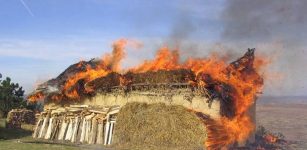 Mysterious Cucuteni-Tyrpillian Culture Burned Their Settlements For Unknown Reasons
Civilizations | Feb 12, 2021
Mysterious Cucuteni-Tyrpillian Culture Burned Their Settlements For Unknown Reasons
Civilizations | Feb 12, 2021 -
 Troll Cross – Protection Symbol Believed To Ward Off Evil Powers
Ancient Symbols | May 12, 2018
Troll Cross – Protection Symbol Believed To Ward Off Evil Powers
Ancient Symbols | May 12, 2018 -
 Unknown Ancient Settlement Overlapping The Old City Of Nakhon Ratchasima Discovered
Archaeology | Mar 14, 2025
Unknown Ancient Settlement Overlapping The Old City Of Nakhon Ratchasima Discovered
Archaeology | Mar 14, 2025 -
 Ancient Petroglyphs In Toro Muerto Are Not What We Thought – Archaeologists Say
Archaeology | May 24, 2024
Ancient Petroglyphs In Toro Muerto Are Not What We Thought – Archaeologists Say
Archaeology | May 24, 2024 -
 Hamingja – Norse Guardian Spirit Bringing Good Luck From Generation To Generation
Myths & Legends | May 20, 2024
Hamingja – Norse Guardian Spirit Bringing Good Luck From Generation To Generation
Myths & Legends | May 20, 2024 -
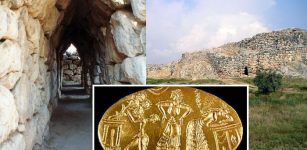 Ancient Mystery Of The Tomb Of Tiryns – Burial Place For An Unknown Mycenaean Hero?
Featured Stories | Jan 11, 2021
Ancient Mystery Of The Tomb Of Tiryns – Burial Place For An Unknown Mycenaean Hero?
Featured Stories | Jan 11, 2021 -
 Mysterious Ancient European Cloaked Individuals – Who Were These Perplexing Beings?
Featured Stories | Mar 15, 2025
Mysterious Ancient European Cloaked Individuals – Who Were These Perplexing Beings?
Featured Stories | Mar 15, 2025 -
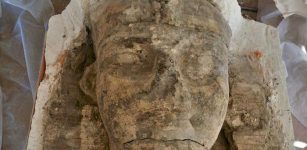 Giant Blocks For Sphinx-Shaped King Amenhotep III Colossi Uncovered In Luxor, Egypt
Archaeology | Jan 23, 2022
Giant Blocks For Sphinx-Shaped King Amenhotep III Colossi Uncovered In Luxor, Egypt
Archaeology | Jan 23, 2022 -
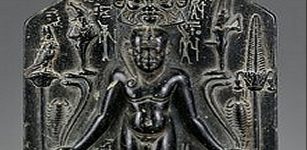 Miniature Magical Stela Of God Horus-Child Standing On Crocodiles Protected Against Wild And Poisonous Creatures
Artifacts | Aug 16, 2019
Miniature Magical Stela Of God Horus-Child Standing On Crocodiles Protected Against Wild And Poisonous Creatures
Artifacts | Aug 16, 2019 -
 Paris Catacombs: Huge Underground Labyrinth Full Of Secrets
Featured Stories | Jan 3, 2016
Paris Catacombs: Huge Underground Labyrinth Full Of Secrets
Featured Stories | Jan 3, 2016 -
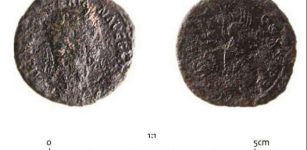 Hoard Of Roman Bronze Coins Turns Out To Be Offering For Safe Crossing
Archaeology | Jul 2, 2021
Hoard Of Roman Bronze Coins Turns Out To Be Offering For Safe Crossing
Archaeology | Jul 2, 2021 -
 Earth’s First Animals Had Particular Taste In Real Estate
Evolution | May 10, 2023
Earth’s First Animals Had Particular Taste In Real Estate
Evolution | May 10, 2023 -
 Mythical Stymphalian Birds: Terrible Winged Maidens With Birds’ Feet
Featured Stories | Feb 27, 2017
Mythical Stymphalian Birds: Terrible Winged Maidens With Birds’ Feet
Featured Stories | Feb 27, 2017 -
 Viking Funeral Traditions: Burning Ships, Complex Ancient Rituals And Incredible Up Helly Aa Festival
Ancient Traditions And Customs | Jan 28, 2017
Viking Funeral Traditions: Burning Ships, Complex Ancient Rituals And Incredible Up Helly Aa Festival
Ancient Traditions And Customs | Jan 28, 2017 -
 Did The Dogon Tribe Have Knowledge Of Theoretical Physics 5,000 Years Ago?
Ancient Mysteries | Aug 2, 2017
Did The Dogon Tribe Have Knowledge Of Theoretical Physics 5,000 Years Ago?
Ancient Mysteries | Aug 2, 2017 -
 Fall Equinox Explains Unusual Alignment Of Egypt’s Great Pyramids – Engineer Says
Archaeology | Feb 26, 2018
Fall Equinox Explains Unusual Alignment Of Egypt’s Great Pyramids – Engineer Says
Archaeology | Feb 26, 2018 -
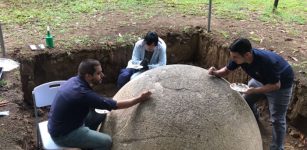 Six Ancient Giant Stone Spheres Recovered From The Diquís Delta, Costa Rica
Archaeology | Apr 7, 2022
Six Ancient Giant Stone Spheres Recovered From The Diquís Delta, Costa Rica
Archaeology | Apr 7, 2022 -
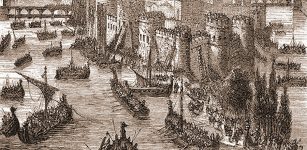 On This Day In History: ‘Sea King’ Ragnar Lodbrok Seizes Paris – On March 28, 845
Featured Stories | Mar 28, 2016
On This Day In History: ‘Sea King’ Ragnar Lodbrok Seizes Paris – On March 28, 845
Featured Stories | Mar 28, 2016 -
 The Carthaginians’ Secret: Mysterious Desert Land Or America Found By Mistake?
Ancient Mysteries | Jul 27, 2017
The Carthaginians’ Secret: Mysterious Desert Land Or America Found By Mistake?
Ancient Mysteries | Jul 27, 2017 -
 Kelpie – Supernatural Horse-Liked Creature Lures Humans To Death In Scottish Lore
Featured Stories | Dec 29, 2021
Kelpie – Supernatural Horse-Liked Creature Lures Humans To Death In Scottish Lore
Featured Stories | Dec 29, 2021


